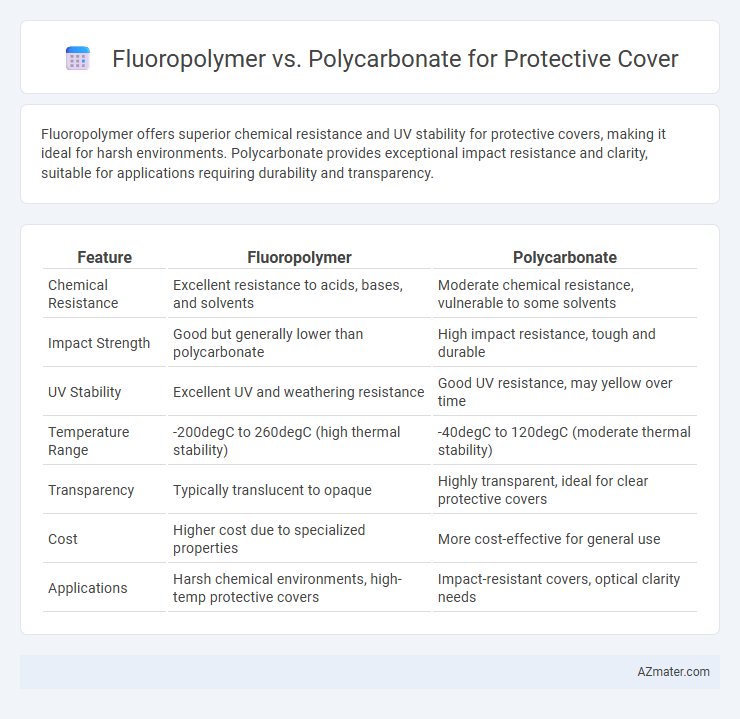Fluoropolymer offers superior chemical resistance and UV stability for protective covers, making it ideal for harsh environments. Polycarbonate provides exceptional impact resistance and clarity, suitable for applications requiring durability and transparency.
Table of Comparison
| Feature | Fluoropolymer | Polycarbonate |
|---|---|---|
| Chemical Resistance | Excellent resistance to acids, bases, and solvents | Moderate chemical resistance, vulnerable to some solvents |
| Impact Strength | Good but generally lower than polycarbonate | High impact resistance, tough and durable |
| UV Stability | Excellent UV and weathering resistance | Good UV resistance, may yellow over time |
| Temperature Range | -200degC to 260degC (high thermal stability) | -40degC to 120degC (moderate thermal stability) |
| Transparency | Typically translucent to opaque | Highly transparent, ideal for clear protective covers |
| Cost | Higher cost due to specialized properties | More cost-effective for general use |
| Applications | Harsh chemical environments, high-temp protective covers | Impact-resistant covers, optical clarity needs |
Introduction to Protective Cover Materials
Fluoropolymer and polycarbonate represent two prominent materials for protective covers, each offering distinct advantages in durability and chemical resistance. Fluoropolymers provide exceptional resistance to harsh chemicals, UV radiation, and extreme temperatures, ensuring long-lasting protection in demanding environments. Polycarbonate excels in impact resistance and transparency, making it ideal for applications requiring clear visibility combined with robust physical protection.
Overview of Fluoropolymer
Fluoropolymer offers exceptional chemical resistance, high-temperature stability, and excellent weathering durability, making it ideal for protective covers in harsh environments. Its low surface energy provides superior non-stick and anti-corrosion properties compared to polycarbonate, which is more prone to UV degradation and scratching. Fluoropolymers, such as PTFE and FEP, maintain structural integrity under extreme conditions, ensuring long-lasting protection for sensitive equipment.
Overview of Polycarbonate
Polycarbonate is a durable, lightweight thermoplastic known for its high impact resistance and excellent optical clarity, making it ideal for protective covers. It offers superior toughness and can withstand harsh environmental conditions, including UV exposure and temperature fluctuations. Polycarbonate's ease of fabrication and ability to be molded into complex shapes enhance its versatility for protective applications compared to fluoropolymers.
Mechanical Strength Comparison
Fluoropolymers exhibit exceptional chemical resistance and flexibility but generally have lower mechanical strength and impact resistance compared to polycarbonate, which offers superior tensile strength and high-impact durability ideal for protective covers. Polycarbonate's high modulus and toughness make it more resistant to cracking under stress, while fluoropolymers provide better resistance to harsh environmental conditions but sacrifice rigidity. For applications prioritizing mechanical strength and impact resistance, polycarbonate is the preferred material over fluoropolymers.
Chemical and UV Resistance
Fluoropolymers exhibit exceptional chemical resistance, effectively withstanding exposure to aggressive solvents, acids, and bases without degradation, making them ideal for protective covers in harsh chemical environments. Their inherent UV stability prevents yellowing and embrittlement under prolonged sunlight, ensuring long-term durability. In contrast, polycarbonate offers moderate chemical resistance but tends to degrade and discolor when exposed to UV radiation unless treated with UV stabilizers, limiting its suitability for outdoor or highly corrosive settings.
Optical Clarity and Transparency
Fluoropolymer films exhibit superior optical clarity with high light transmittance and low haze, making them ideal for applications requiring transparent protective covers. Polycarbonate offers good transparency but often falls short in maintaining long-term optical clarity due to yellowing and scratching under UV exposure. Fluoropolymers maintain consistent transparency and resist discoloration, ensuring durable, clear protective covers in harsh environments.
Temperature Tolerance and Stability
Fluoropolymers exhibit exceptional temperature tolerance, maintaining structural integrity in extreme conditions from -200degC to over 260degC, making them ideal for protective covers exposed to high heat or cryogenic environments. Polycarbonate, while offering good impact resistance and clarity, typically withstands temperatures only up to around 135degC before deforming or losing stability. The superior thermal stability of fluoropolymers ensures long-term durability and resistance to thermal degradation, whereas polycarbonate covers may require additional treatments or reinforcements to perform reliably under high-temperature stress.
Weight and Flexibility Analysis
Fluoropolymer protective covers exhibit lower density, resulting in reduced weight compared to polycarbonate alternatives, enhancing portability and ease of installation. Fluoropolymers offer superior flexibility with higher elongation at break values, allowing for better impact absorption and adaptability to varying shapes without cracking. Polycarbonate, while heavier and stiffer, provides excellent rigidity but lacks the same degree of flexibility essential for dynamic applications requiring lightweight, durable protection.
Typical Applications and Industry Usage
Fluoropolymer protective covers are widely used in harsh chemical, aerospace, and semiconductor industries due to their exceptional chemical resistance, high-temperature tolerance, and non-stick properties. Polycarbonate covers are preferred in automotive, electrical, and consumer electronics sectors for their impact resistance, clarity, and UV protection. Both materials serve critical roles, with fluoropolymers excelling in extreme environments and polycarbonates offering durability and transparency in protective applications.
Cost Effectiveness and Sustainability
Fluoropolymer protective covers offer exceptional chemical resistance and durability, often lasting significantly longer than polycarbonate alternatives, which reduces replacement frequency and long-term costs. Polycarbonate covers provide lower upfront costs and high impact resistance but may degrade faster under UV exposure, leading to more frequent replacements and potential environmental waste. Choosing fluoropolymers enhances sustainability by minimizing material turnover and waste, while polycarbonate's lower initial cost suits budget-sensitive applications despite higher lifecycle environmental impacts.

Infographic: Fluoropolymer vs Polycarbonate for Protective Cover
 azmater.com
azmater.com